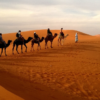When you think of Egypt, the Pyramids, Sphinx, and ancient temples may come to mind, but Egypt’s rich natural landscapes offer more than just echoes of ancient civilizations. Beyond the sands of the Sahara and the bustle of Cairo lies a haven for nature lovers—teeming with bird species and unique wildlife. Whether you’re a seasoned birder or a curious explorer, Egypt’s hidden natural wonders invite you to discover a vibrant ecosystem shaped by the Nile, deserts, and coastal regions.
The Best Places for Birdwatching in Egypt
The Nile Valley and Delta
The Nile River isn’t just the lifeblood of Egypt’s people; it’s also a haven for birdlife. The Nile Delta in the north is a prime location for spotting migratory birds. From September to April, the skies here fill with storks, flamingos, herons, and pelicans. The delta’s wetlands, lush vegetation, and waterways make it a vibrant habitat. The Nile Valley itself is a lifeline for several endemic bird species, including the Egyptian goose and the Nile Valley Sunbird.
Wadi El Rayan Protected Area
Located in the Fayoum Oasis, Wadi El Rayan is known for its man-made lakes and picturesque waterfalls. This protected area is also a paradise for birdwatchers. Here, you might catch sight of the elusive white-tailed plover, black-winged stilt, or the sociable lapwing. Beyond birds, Wadi El Rayan is home to the rare Egyptian gazelle and a stunning variety of wildflowers.
Lake Nasser: An Ornithologist’s Dream
Lake Nasser, formed by the Aswan High Dam, is not just a massive reservoir but a significant birding site. The lake’s islands and shores are ideal for seeing African fish eagles, ospreys, and the glossy ibis. Keep an eye on the water’s edge for Nile monitors and occasional desert foxes. Lake Nasser’s remote location and serene environment make it a gem for those seeking an off-the-beaten-path adventure.
Ras Mohammed National Park
At the southern tip of the Sinai Peninsula lies Ras Mohammed National Park, a renowned marine and terrestrial reserve. While many come for the world-class diving, the park is also a key birdwatching spot. During migration seasons, thousands of storks, gulls, and terns stop at Ras Mohammed. The park’s mangroves and coastal areas attract greater flamingos and the Eurasian spoonbill, offering bird lovers an unforgettable spectacle.
Wildlife Spotting in Egypt’s Hidden Gems
The White Desert
The surreal landscapes of the White Desert, with its chalk-white rock formations, are not only visually striking but are also home to a surprising array of wildlife. Desert foxes (fennec foxes), sand cats, and Barbary sheep roam the area, adapted to the arid environment. Early mornings and evenings are the best times to spot these elusive creatures in the shimmering light of the desert sun.
Gebel Elba National Park
Located in the southeastern corner of Egypt, near the Sudanese border, Gebel Elba is one of the country’s most biologically diverse areas. This mountainous region is a hidden gem for adventurers. The park is home to Nubian ibex, Dorcas gazelles, and a variety of reptiles. Bird enthusiasts can marvel at rare species like the Verreaux’s eagle, Arabian bustard, and the Pharaoh eagle-owl.
Siwa Oasis
Siwa Oasis, famous for its salt lakes and date palms, offers a unique birdwatching experience. The tranquil environment and abundant water sources draw species like the Egyptian nightjar and the pale rock sparrow. The oasis is also known for its populations of desert foxes and the Siwa mongoose, making it a great destination for wildlife enthusiasts.
What to Bring and Tips for Birdwatching & Wildlife Spotting in Egypt
Binoculars & Camera: Bring good quality binoculars for birdwatching and a camera with a zoom lens to capture Egypt’s fascinating wildlife.
Guidebooks & Apps: A bird identification guide specific to Egypt or North Africa will be helpful. Many birders also use birding apps to keep track of sightings.
Early Mornings & Evenings: Wildlife is most active during the cooler parts of the day, so plan your outings early in the morning or at dusk for the best chances of spotting.
Stay Respectful & Keep Distance: Always keep a safe distance from wildlife to avoid disturbing them, especially during nesting or mating seasons.
Final Thoughts
Egypt’s natural landscapes are as fascinating as its ancient history. Whether exploring the wetlands of the Nile, trekking through deserts, or standing by the serene lakes of the Sinai, Egypt offers incredible opportunities for birdwatching and wildlife spotting. Beyond the monuments and mysteries of the past lies a vibrant world waiting to be explored by nature enthusiasts. Take a step off the well-worn paths and discover the hidden wonders of Egypt’s ecosystems.









